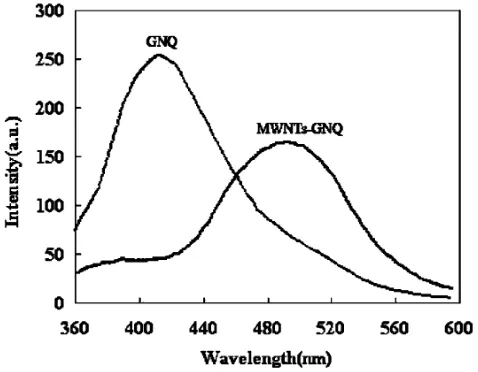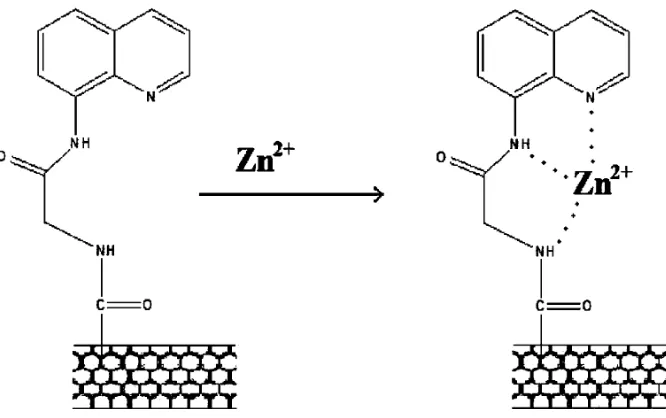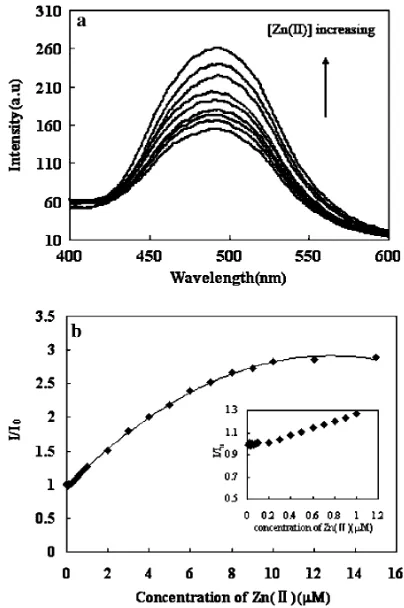N A N O E X P R E S S
Quinoline Group Modified Carbon Nanotubes for the Detection
of Zinc Ions
Zhengping DongÆ Bin YangÆJun JinÆ Jing LiÆ Hongwei KangÆXing ZhongÆ Rong LiÆJiantai Ma
Received: 18 November 2008 / Accepted: 30 December 2008 / Published online: 21 January 2009
Óto the authors 2009
Abstract Carbon nanotubes (CNTs) were covalently modified by fluorescence ligand (glycine-N-8-quinolyla-mide) and formed a hybrid material which could be used as a selective probe for metal ions detection. The anchoring to the surface of the CNTs was carried out by the reaction between the precursor and the carboxyl groups available on the surface of the support. Fourier transform infrared spectroscopy (FTIR) and Thermogravimetric analysis (TGA) unambiguously proved the existence of covalent bonds between CNTs and functional ligands. Fluorescence characterization shows that the obtained organic–inorganic hybrid composite is highly selective and sensitive (0.2lM) to Zn(II) detection.
Keywords Carbon nanotubes
Glycine-N-8-quinolylamideZn(II)Fluorescent material
Detection
Introduction
There has been growing interest during the last decade in the development of fluorescent molecular sensors for cat-ions and ancat-ions in solution [1–8]. Especially, fabricating fluorescent materials for the detection of Zinc cation has drawn much more attention [9–13], as Zinc not only plays important roles in human bodies [14,15], but also closely
relates to severe pathological diseases such as Alzheimer’s and Parkinson’s diseases [16]. So far, much study has been done for the detection and real-time localization of Zn(II). Yasuhiro Shiraishi’s group has synthesized a quinoline– polyamine conjugate as a fluorescent chemosensor for quantitative detection of Zn(II) in water [17]. Maarten Merkx et al. used chelating fluorescent protein chimeras for ratiometric detection of Zn(II) in living cells and the detection range was from 10 nM to 1 mM [18]. Jinshi Ma and coworkers have synthesized several bis(pyrrol-2-yl-methyleneamine) ligands as fluorescent sensor for Zn(II) [11], and their results revealed that the ligands exhibit excellent fluorescent properties. However, much of the work was just based on organic molecules as fluorescent chemosensors. For a few practical applications the attachment of the fluorescent units to a solid support has advantages like the possibility of recovering the materials for their repetitive use. For this point, scientists chose silica nanoparticles [12], nanosized boehmite par-ticles [13] and silicon nanowires [19] to support fluoresence ligands as fluorescence sensors. And these materials exhibit excellent selectivity and sensitivity to sense metal ions.
In this study, we chose multi-walled carbon nanotubes (MWNTs) as fluorescent support. Since its discovery, surface modification of MWNTs has received considerable attention [20–24]. The fluorophore in this study is glycine-N-8-quinolylamide (GNQ) molecule, in light of the fact that the 8-aminoquinoline derivatives could effectively coordinate with specific metal ions [25]. The quinoline group has been covalently grafted to the surface of the MWNTs that can behave as recognition center for metal ions depending on its actual protonation state. We find that this new material (MWNTs-GNQ) has high selectivity and sensitivity to detect Zn(II), and the sensitivity is down to
Z. DongB. YangJ. JinJ. LiH. KangX. Zhong
R. LiJ. Ma (&)
College of Chemistry and Chemical Engineering, Lanzhou University, Lanzhou 730000, People’s Republic of China e-mail: majiantai@lzu.edu.cn
R. Li
0.2lM., which is about the same as the silica nanoparti-cles-supported fluorescence sensors [12]. For other sensing materials [26,27], the fluorescence enhancement selectiv-ity is not only for Zn(II) but also for Cd(II), which may reduce selectivity when they are used just for Zn(II) detection. On the other hand, the fluorescence enhancement of MWNTs-GNQ is only for Zn(II).
As the use of organic–inorganic hybrid materials for bio-application has become a hot subject in the research field currently [28–31], MWNTs-GNQ may be used to build nanosensor devices to sense directly in intracellular environment, because carbon nanotubes (CNTs) can pen-etrate into cells and almost have no toxicity to organism [32,33].
Experimental
Materials
The multi-walled carbon nanotubes (MWNTs, diameters: 20–40 nm, purity: 95–98%) prepared by the catalytic decomposition of CH4 were provided by Shengzhen Nanotech Port Ltd. Co (China). Methanol and Tetrahy-drofuran were used after distillation. Other reagents were analytical and used without purification. Glycine-N-8-quinolylamide (GNQ) was synthesized according to the known method [34].
Purification of MWNTs
In a typical experiment, 300 mg pristine-MWNTs were added to a 180 mL 3:1 mixture of concentrated H2SO4and HNO3. The mixture was treated in an ultrasonic bath (40 kHz) for 20 min and stirred at 60°C for 4 h under
reflux. Then, the mixture was vacuum-filtered through a 0.22lm Millipore polytetrafluoroethylene membrane and washed with distilled water until pH of the filtrate was 7. The filter cake was dried under vacuum at 40°C for 24 h to obtain MWNTs-COOH.
Functionalization of MWNTs (Scheme 1)
The acid-treated MWNTs-COOH of 200 mg was reacted with 20 mL SOCl2 for 24 h under reflux, and then the residual SOCl2was removed by the reduced pressure dis-tillation, the solid was washed with anhydrous THF several times until the brown-colored supernatant became to col-orless. The remaining solid acyl chloride-functionalized MWNTs (MWNTs-COCl) was dried under vacuum at 20°C for 24 h.
MWNTs-COCl of 100 mg was dispersed in 10 mL anhydrous chloroform and the mixture was sonicated for 20 min to create a homogeneous suspension. The mixture was added with 50 mg GNQ under a nitrogen atmosphere, and then immersed in an oil bath at 70°C accompained by mechanical stirring for 24 h. The resulting reaction med-ium was vacuum-filtered through a 0.22lm polycarbonate membrane three times to yield MWNTs-GNQ.
All the reactions in the experimental procedure were carried out under a nitrogen atmosphere.
Characterization and Test of the Materials
Fourier transform infrared (FTIR) spectrometer (Bruker IFS66/S), Dupont-1090 Thermal gravimetric analysis (TGA) instrument and Gmbh Varioel Elementar Analy-sensyteme were used to characterize the materials. Perkin Elmer LS 55 spectrofluorimeter was used to obtain the fluorescence spectra of the fluorescence material.
Results and Discussion
Figure1 shows the infrared spectra of a GNQ and b MWNTs-GNQ. In the FTIR spectrum of GNQ, the absorption peaks at 3383.64 cm-1, 3290.48 cm-1(–NH2), 2890.5 cm-1(C–H), 1658.27 cm-1(C=O), 1593.29 cm-1 (N–H), 1523.3 cm-1(C–C), and 1059.01 cm-1(C–N) are found. Comparing with the FTIR spectrum of GNQ, the characteristic peaks of amino groups in the spectrum of MWNTs-GNQ disappeared, demonstrating that the amino groups on GNQ have reacted with acyl chloride groups on the surface of MWNTs. A new peak that appeared around 1686 cm-1 is attributed to the amide carbonyl (C=O) stretch. Another new peak at 1629.87 cm-1is attributed to secondary amide band which accompanies the absorption at 1686 cm-1. Another peak at 1082.47 cm-1attributed to (C–N) has also been found, and it has obviously been enhanced. The results indicate that GNQ has been grafted to the surface of MWNTs.
The TGA curves of MWNTs-COOH and MWNTs-GNQ were recorded on a Dupont-1090 thermogravimeter in Ar atmosphere at the heating rate 10°C/min from 20°C to 500°C (Fig.2). According to Fig.2a, there is a continuous weight lose of the MWNTs-COOH, and the amount of the weight loss is about 10% typical for acid-functionalized MWNTs. The weight loss curves in Fig.2b, the major weight loss happened in the temperature range from 200°C to 450°C due to the degradation of the GNQ grafted to the MWNTs. The content of the GNQ grafted to the MWNTs is about 12 wt%, which is similar to the cal-culation result of the elemental microanalysis (Table1).
The fluorescence spectra of GNQ and MWNTs-GNQ are shown in Fig.3. It can be seen that the fluorescence peak is red-shifted after modification. Compared with GNQ, the fluorescence intensity of MWNTs-GNQ is
decreased. It may be affected by the black background of CNTs.
GNQ is expected to be a stronger coordinating agent because it is a tridentate ligand. When GNQ is selectively coordinated with metal ions, the fluorescence from GNQ is modified appropriately by the metal ions. This phenome-non can be utilized to construct a material for the detection of metal ions based on MWNTs (Scheme2). Accordingly,
Fig. 1 FTIR spectra ofaGNQ andbMWNTs-GNQ
[image:3.595.306.543.54.246.2]Fig. 2 TGA ofaMWNTs-COOH andbMWNTs-GNQ
Table 1 Elemental microanalysis for MWNTs-GNQ
Element Content (%)
C 74.27
N 2.629
H 1.238
[image:3.595.304.546.300.361.2] [image:3.595.306.545.502.688.2] [image:3.595.53.287.510.697.2]titration of various metal ions in the presence of MWNTs-GNQ in methanol solution was performed, and the results are summarized in Fig.4. After titration of various metal ions, it is observed that the intensity of fluorescence from MWNTs-GNQ containing Zn(II) is much higher than that of other metal ions. This is very nice because under many conditions (e.g., physiological conditions) various metal ions may exist at certain concentrations compared to Zn(II).
It was reported that most of the previous Zn(II) sensors do not exhibit good selectivity to these metal cations [26,
27] (for instance, the selectivity in many cases is close to 1:1 for Zn(II):Cd(II)). This may bring trouble to certain applications where Co(II), Ni(II), Cu(II), or Cd(II) may interfere (e.g., in environmental science). Herein, MWNTs-GNQ shows 2.8-fold fluorescence enhancement for Zn(II) versus just minimal fluorescence enhancement for Cd(II) and Ni(II). From these results, it is evident that MWNTs-GNQ have a high selectivity to Zn(II).
As for selectivity of MWNTs-GNQ to metal ions, when Zn(II) forms a complex with MWNTs-GNQ with a suitable radius and an electronic structure 3d104 s0, the electron-transfer process of MWNTs-GNQ is forbidden [35], and an extended p–electron conjugation system is formed syn-chronously. This conjugation system is involved in an internal charge transfer process from the ligand donor to the Zn(II) acceptor, and simultaneously inhibits the exci-ted-state proton transfer and photo-induced electron transfer that strongly suppress the fluorescence of MWNTs-GNQ. Thus Zn(II) considerably enhances the fluorescence of MWNTs-GNQ.
To further characterize the performance of the sensing material for Zn(II), a series of comparison experiments were carried out with MWNTs-GNQ. Because Zn(II) always coexists with Cu(II) or Cd(II), titration addition of 1 910-5M Cu(II) and Cd(II) to MWNTs-GNQ solution containing Zn(II) led to contrary results (Fig.5). When Cu(II) was added to the solution, it led to about 97.5% quenching of the total fluorescence intensity, probably because Cu(II) formed some complex with GNQ group, resulting in quenching of fluorescence as reported [36]. But Cd(II) almost had no influence on the fluorescence inten-sity of the MWNTs-GNQ solution containing Zn(II), because the electronic structure of Cd(II) is fairly similar to that of Zn(II). To resolve the problem of fluorescence quenching by Cu(II), a masking agent of Na2S2O3 was chosen. As is well known that S2O32- can form a very stable complex with Cu(II), the coordination number is three, and Na(I) almost has no influence to fluorescence intensity of MWNTs-GNQ. The results are shown in Fig.5, from which we can see that the masking agent almost does not affect the experimental results except in the case when the system contains Zn(II) and Cu(II). When three stoichiometry S2O32- were added to the Zn(II) and Scheme 2 Fluorescent
chemosensor (MWNTs-GNQ) for detection of Zn(II)
[image:4.595.206.539.56.265.2] [image:4.595.51.290.536.687.2]Cu(II) solution, the fluorescence intensity was greatly enhanced. Although, compared to the solution only con-taining Zn(II), the intensity was a little weaker, Na2S2O3is still a good masking agent to mask Cu(II). We thus con-clude that the presence of Cd(II) does not affect the sensitivity of MWNTs-GNQ for Zn(II) detection, and Na2S2O3 could be used as a masking agent when Cu(II) coexists in the system.
The sensitivity of fluorescence enhancing from MWNTs-GNQ by Zn(II) was further investigated, and the results are shown in Fig.6a. The fluorescence intensity of MWNTs-GNQ gradually increased with increasing Zn(II) concentration. When more than 1 eq. Zn(II) was added, only a marginal increase was observed (Fig.6b), which suggested the 1:1 stoichiometry of the ligand to the zinc ions. Because Zn(II) desires a square planar geometry when coordinated, while the three nitrogen on MWNTs-GNQ can only provide a tridentate ligand, the fourth coordination can come from the solvent methanol oxygen. It can be seen from Fig.6b that when the concentration of Zn(II) is lower than 0.2lM, the relative fluorescence intensity is about 1. But when the concentration of Zn(II) is higher than 0.2lM, the relative fluorescence intensity is also increased. It can be expressed by the following formula:
A¼ 0:012C2þ0:3055Cþ0:9658;R2¼0:9993: ð1Þ
Wherein,Ais the value of the fluorescence intensity, Cis the concentration of Zn(II), and the range of C is from 0.2lM to 10lM in this study. So, it is evident that the detection limit for Zn(II) is established at 0.2lM under the experimental conditions in our study.
Summary
We have prepared a new organic–inorganic hybrid sensing material based on CNTs as support and glycine-N-8-quinolylamide as fluorescent center. The results of the fluorescence characterization show that the composite has a highly selective and sensitive (0.2lM) detection for Zn(II), and reveal that ratiometric Zn(II) sensing is possible with fluorophore chemically modified carbon nanotubes. This novel fluorescent material may be used as a fluores-cent device in intracellular environment for the detection of Zn(II).
References
1. B. Valeur, I. Leray, Coord. Chem. Rev.205, 3 (2000)
2. A. Moghimi, B. Maddah, A. Yari, M. Shamsipur, M. Boostani, M.F. Rastegar, A.R. Ghaderi, J. Mol. Struct.752, 68 (2005) 3. Z. Liang, Z.L. Liu, L. Jiang, Y.H. Gao, Tetrahedron Lett.48,
1629 (2007)
4. F.T. Lu, L.N. Gao, H.H. Li, L.P. Ding, Y. Fang, Appl. Surf. Sci
253, 4123 (2007)
Fig. 5 Relative fluorescence intensity of MWNTs-GNQ (1910-5M) or MWNTs-GNQ (1910-5M) containing S2O32
[image:5.595.51.292.56.237.2]-(3910-5M) in the presence of Zn(II) (1910-5M) and interfering ions with Cu(II) (1910-5M) or Cd(II) (1910-5M), respectively. Methanol solution.kex=324 nm
[image:5.595.322.524.58.362.2]5. R. Martinez, A. Espinosa, A. Tarraga, P. Molina, Tetrahedron64, 2184 (2008)
6. C.F. Chow, M.H.W. Lam, M.K.P. Leung, Anal. Chim. Acta466, 17 (2002)
7. Y. Dai, X. Hu, C. Wang, D.P. Chen, X.G. Jiang, C.S. Zhu, B.K. Yu, J.R. Qiu, Chem. Phys. Lett.439, 81 (2007)
8. Q.Y. Chen, C.F. Chen, Tetrahedron Lett.46, 165 (2005) 9. V. Bereau, Inorg. Chem. Comm.7, 829 (2004)
10. Z.L. Chen, X.L. Li, F.P. Liang, J. Solid State Chem.181, 2078 (2008)
11. Z.K. Wu, Q.Q. Chen, G.Q. Yang, C.B. Xiao, J.G. Liu, S.Y. Yang, J.S. Ma, Sensor. Actuat. B99, 511 (2004)
12. P. Teolato, E. Rampazzo, M. Arduini, F. Mancin, P. Tecilla, U. Tonellato, Chem. Eur. J.13, 2238 (2007)
13. R. Aucejo, J. Alarcon, C. Soriano, M.C. Guillem, E.G. Espana, F. Torres, J. Mater. Chem.15, 2920 (2005)
14. E.H. Cox, G.L. McLendon, Curr. Opin. Chem. Biol. 4, 162 (2000)
15. P. Jiang, Z. Guo, Coord. Chem. Rev.248, 205 (2004)
16. S.W. Suh, K.B. Jensen, M.S. Jensen, D.S. Silva, P.J. Kesslak, G. Danscher, C. Frederickson, J. Brain Res.852, 274 (2000) 17. Y. Shiraishi, C. Ichimura, T. Hirai, Tetrahedron Lett.48, 7769
(2007)
18. T.H. Evers, M.A.M. Appelhof, P.T.H.M. de Graaf-Heuvelmans, E.W. Meijer, M. Merkx, J. Mol. Biol.374, 411 (2007) 19. L.X. Mu, W.S. Shi, J.C. Chang, S.T. Lee, Nano Lett. 8, 104
(2008)
20. J. Chen, M.A. Hamon, H. Hu, Y.S. Chen, A.M. Rao, P.C. Eklund, R.C. Haddon, Science282, 95 (1998)
21. B.P. Singh, D. Singh, R.B. Mathur, T.L. Dham, Nanoscale Res. Lett.3, 444 (2008)
22. S.H. LIM, J.Y. LIN, Functional Mater. Lett.1, 1 (2008) 23. E. Lioudakis, A. Othonos, I. Alexandrou, Nanoscale Res. Lett.3,
278 (2008)
24. Z.X. Xu, P.A. Hu, S.M. Wang, X.H. Wang, Appl. Surf. Sci.254, 1915 (2008)
25. Q.E. Cao, K.T. Wang, Z.D. Hu, Q.H. Xu, Talanta47, 921 (1998) 26. Y. Mikata, M. Wakamatsu, A. Kawamura, N. Yamanaka, S. Yano, A. Odani, K. Morihiro, S. Tamotsu, Inorg. Chem.45, 9262 (2006)
27. Y. Mikata, M. Wakamatsu, S. Yano, Dalton Trans. 545 (2005) 28. X. Shi, B. Sitharamana, Q.P. Pham, F. Liang, K. Wu, W.E.
Billups, L.J. Wilson, A.G. Mikos, Biomaterials28, 4078 (2007) 29. B. Saha, J. Bhattacharya, A. Mukherjee, A.K. Ghosh, C.R. Santra, A.K. Dasgupta, P. Karmakar, Nanoscale Res. Lett.2, 614 (2007)
30. B.S. Harrison, A. Atala, Biomaterials28, 344 (2007)
31. S.A. Corr, Y.P. Rakovich, Y.K. Gun’ko, Nanoscale Res. Lett.3, 87 (2008)
32. S.T. Yang, X. Wang, G. Jia, Y.Q. Gu, T.C. Wang, H.Y. Nie, C.C. Ge, H.F. Wang, Y.F. Liu, Toxicol. Lett.181, 182 (2008) 33. K. Pulskamp, S. Diabate, H.F. Krug, Toxicol. Lett. 168, 58
(2007)
34. J.Y. Zhang, X.Y. Wang, C. Tu, J. Lin, J. Ding, L.P. Lin, Z.M. Wang, C. He, C.H. Yan, X.Z. You, Z.J. Guo, J. Med. Chem.
46, 3502 (2003)
35. L.V. Meervelt, M. Goethals, N. Leroux, T. Zeegers-Huyskens, J. Phys. Org. Chem.10, 680 (1997)


